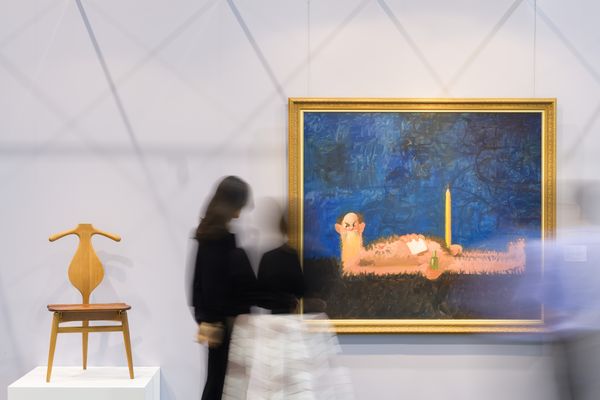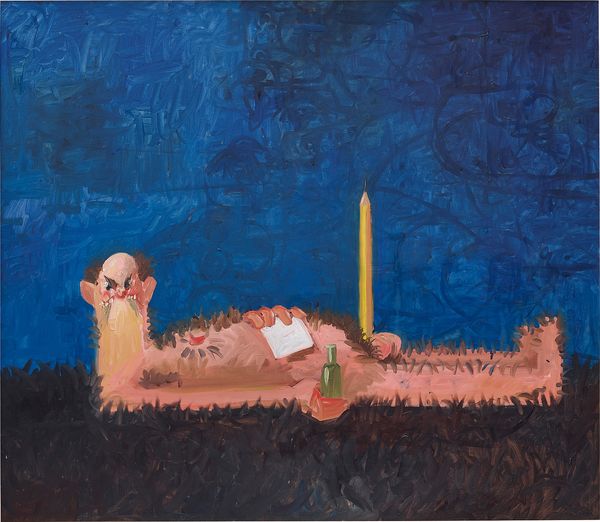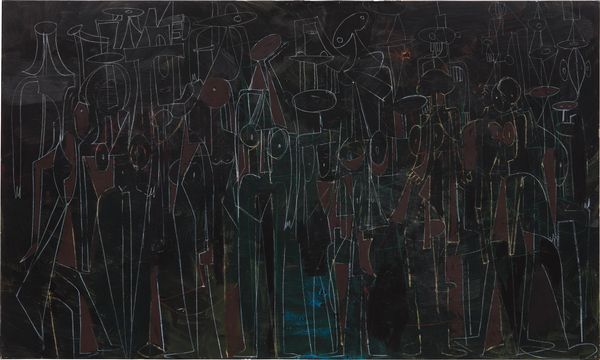George Condo Writer, 2006, as seen on view in Taipei
Situated in a non-specific yet playfully macabre landscape, George Condo's absurd and consciously lewd Writer confronts the viewer head-on.
Carefully amalgamating a pantheon of stylistic references from the breadth of art history — from the Renaissance to Cubism — Condo turns the academic genre of portrait painting on its head, irreverently delving into modes of caricature and the grotesque. Painted in 2006, Writer can be seen as an extension of Condo's important series known as the existential portraits. By intercepting the genre of portraiture with fictive personas and surreally deformed figures, Condo provides provocative models of the social identities we create and live by. His figures are driven by basic instincts and primal desires.
Grimacing with a protruding jaw and bulbous red cheeks, Writer bears all the hallmarks of Condo's iconic figurative vocabulary. Notably, brushwork is particularly expressive, creating a dynamic surface that vibrates with the raw aesthetic impulses of the artist—a fitting stylistic choice given that the subject parodies the idea of the over-confident, creative individual. Above all, it is Condo's ability to capture the spectrum of human emotions, psychological states and the existential plight of humanity that has made him one of the most revered painters of his generation.
Brushwork is particularly expressive, creating a dynamic surface that vibrates with the raw aesthetic impulses of the artist.
George Condo Writer, 2006
Having once worked in Andy Warhol's factory as a writer and silk screener, Condo's journey to notoriety began in the New York art scene in the 1980s. Having befriended the most important new artists of that time, including Jean-Michel Basquiat and Keith Haring, Condo was determined to carve out his own unique aesthetic idiom. Unlike his contemporaries, rather than looking to the streets and urban life for inspiration, he turned to art history. Among Condo's greatest influences are Old Masters painters such as Diego Velázquez, Neoclassicists such as Jean-Auguste-Dominique Ingres and, above all, the great Cubist Pablo Picasso. It was in the 1980s that Condo began using the terms 'psychological Cubism' and 'artificial realism' to define his approach to art.
Also on offer as part of our Hong Kong Evening Sale of 20th Century & Contemporary Art & Design, the artist's Black Standing Figures from 2000 engulfs the viewer: stretching over two meters wide and nearly life-sized in height, this large-scale painting resembles a wall filled with frenetic graffiti. Approaching the work from a distance, the viewer realizes that the largely black-and-white painted canvas is filled with an immense variety of texture and impressive range of color. This palimpsest-like composition more closely recalls the energy of paintings by Condo's friends and fellow artists from New York—Basquiat and Haring. Simultaneously, it pays tribute to Brassaï's celebrated photographs of street art from mid-twentieth-century Paris.
Condo's ability to cannibalize a range of artistic and conceptual influences, transforming them into something new, is a hallmark of his work.
George Condo Black Standing Figures, 2000
Condo chose to abandon the New York of Haring and Basquiat by spending a number of years in Paris, immersed in the wealth of the European canon and tradition of visual culture. These he absorbed, eventually processing them and imbuing them with the new, vigorous energy that is so apparent in Black Standing Figures. Condo has depicted these massed figures with a manic edge that is heightened by the fragmentary, elusive appearance of the people themselves: here, a hand is glimpsed, there, hair, elsewhere, breasts, all coalescing to give the impression of a crowd facing us. Condo depicts this crowd with disjointed and distorted features in a manner that recalls his now-iconic 'pods', or 'antipodal beings', a notion taken from Aldous Huxley's Heaven and Hell. Looking at Black Standing Figures, there is a clear sense of hallucinatory power to the image; it continues the distortions of 'psychological Cubism' for which he is famous while introducing a new, raw mentality.
Stylistically, Black Standing Figures appears to compress a range of influences. As well as the graffiti of Haring or the paintings of Matta, there is a clear tribute to Pablo Picasso, and in particular to the works of the post-war period when Picasso was in a relationship with fellow artist Françoise Gilot. Comparisons can also be made to Jean Dubuffet, the French painter and sculptor and founder of the Art Brut movement, whose dark, heavily textured canvases are among the defining hallmarks of early 20th-century art.
Left: George Condo Diaries of Milan, 1984. Collection of The Museum of Modern Art, New York © 2018 Georges Condo / Artists Rights Society (ARS), New York; Right: Jean Dubuffet Large Black Landscape, 1946. Collection of the Tate Modern, London © 2018 Artists Rights Society (ARS), New York / ADAGP, Paris
Discussing his own work, Condo has said: "I like to think about Picasso… because he took a bicycle seat and a pair of handlebars and made a bull's head: he reconfigured a manmade thing into a natural thing. What I've done is the reverse: I've turned it back into the bicycle."



